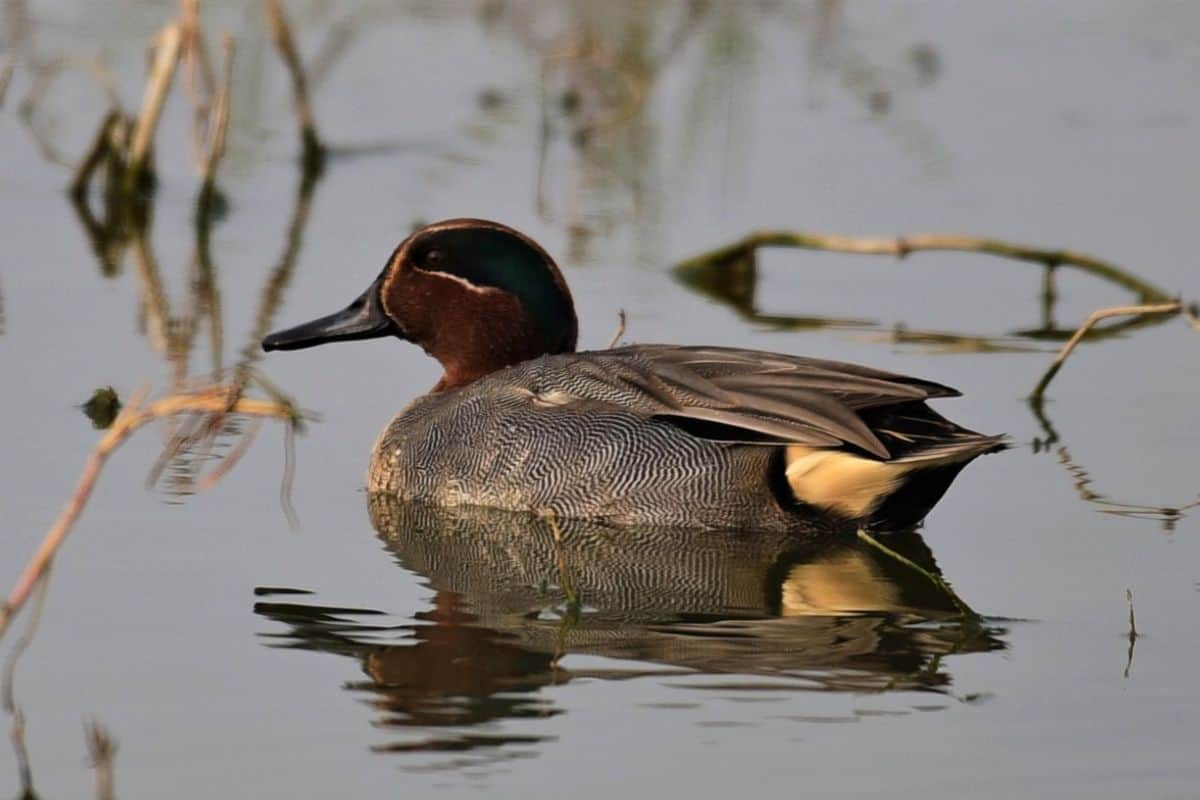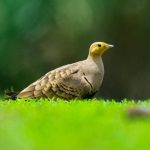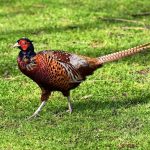Common Name: Green-winged Teal
Scientific Name: Anas carolinensis| Size | Diet | Range in Hawaii | Status in Hawaii |
|---|---|---|---|
| 12 in - 15 in. | aquatic plants, seeds, and invertebrates | Common on all Island | Least Concern |
The green-winged teal (Anas carolinensis) is a small, beautiful duck species that is common in North America. With a 20-23 cm wingspan, these ducks are known for their distinctive green wing patches and ability to fly at high speeds. While they breed in the northern areas of North America, they can also be found in other parts of the world, including Hawaii.
In fact, Hawaii is one of the few places outside of North America where these ducks can be found. Despite their small size, green-winged teals are an important part of the ecosystem and are beloved by birdwatchers and nature enthusiasts alike.
Green-winged Teal
Appearance
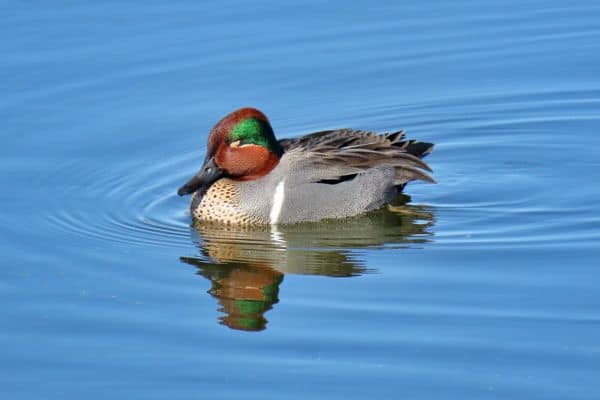
The Green-winged Teal is a small and attractive species of duck. The adult males have a distinct and eye-catching plumage. They have a dark brown head with a vertical white stripe extending from the base of the bill to the neck.
Their chest is also white, while the sides and flanks are finely marked with intricate, wavy patterns in gray and white. The most striking feature of the male Green-winged Teal is its iridescent green patch on the wings, which is particularly visible during flight.
In terms of size, adult Green-winged Teals measure approximately 12-15 inches (30-38 centimeters) in length. Their wingspan ranges from 23-25 inches (58-64 centimeters).
Compared to the males, the females are slightly duller in coloration. They have a mottled brown overall appearance, with a pale blue patch on the forewing, visible in flight.
Diet
The Green-winged Teal has a diverse and adaptable diet that primarily consists of aquatic plants, seeds, and invertebrates. These small dabbling ducks forage both in water and on land, using their specialized bill to filter food from the water or pluck it from the ground.
Aquatic vegetation forms a significant part of their diet, including various types of submerged and emergent plants such as pondweeds, smartweeds, and duckweeds. They also consume seeds and grains from various grasses and sedges.
In addition to plant matter, the Green-winged Teal feeds on a wide range of invertebrates. They commonly consume insects, crustaceans, mollusks, and small aquatic invertebrates. This includes insects like midges, beetles, and mosquito larvae, as well as small snails, clams, and crustaceans found in shallow water or mud.
During the breeding season, Green-winged Teals may also incorporate protein-rich food sources, such as small fish and amphibians, into their diet to meet the increased nutritional demands for reproduction.
Nesting
Green-winged Teals are ground-nesting ducks that typically choose well-concealed locations in dense vegetation near wetlands for their nests. The female takes the primary responsibility for nest construction and incubation, while the male plays a supportive role in defending the territory.
The nest is a shallow depression lined with plant material, feathers, and down. The female carefully arranges the materials to create a comfortable and insulated space for the eggs. The nest is usually situated on the ground, concealed among grasses, reeds, or shrubs, providing protection from predators and minimizing visibility.
Green-winged Teals usually lay a clutch of about 7-10 eggs, which are pale buff to cream in color. The female incubates the eggs for approximately 21-24 days, rarely leaving the nest except for brief periods to feed.
During this time, the male remains nearby, keeping watch and defending the nesting territory from potential threats. Once the eggs hatch, the female leads the precocial ducklings to nearby water sources, where they can swim and forage for small invertebrates and aquatic plants.
The ducklings are capable of swimming and feeding on their own shortly after hatching, but they remain dependent on their mother for protection and guidance. The nesting season of Green-winged Teals typically occurs during spring and early summer, aligning with the availability of food resources and suitable breeding habitats. Their nesting behavior demonstrates their adaptation to wetland environments, where they can find adequate cover and resources for successful reproduction.
Behavior
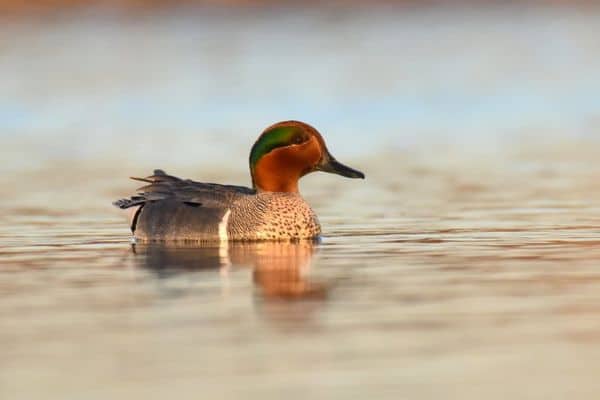
The Green-winged Teal exhibits a range of interesting behaviors that contribute to their survival and successful adaptation to wetland habitats. One notable behavior is their dabbling feeding style.
Green-winged Teals often feed by tipping their head into the water, grazing on aquatic vegetation, and filtering small invertebrates from the surface. They may also forage on land, grazing on seeds and grasses. This feeding behavior allows them to exploit a wide variety of food sources and adapt to changing environmental conditions.
During the breeding season, the males engage in elaborate courtship displays to attract mates. These displays involve rapid wing beats, head jerks, and vocalizations, accompanied by vibrant plumage and the distinctive green patches on their wings. These displays are not only intended to attract females but also to establish dominance and deter potential rivals.
Green-winged Teals are highly social birds and often gather in large flocks, both during the breeding season and in migration. These flocks provide safety in numbers, increasing their chances of detecting predators and reducing individual vulnerability. In terms of migration, Green-winged Teals are known for their long-distance travels.
They undertake seasonal migrations, often flying in V-shaped formations, and can cover substantial distances to reach their breeding or wintering grounds. These migrations are triggered by changes in food availability and weather conditions.
When it comes to defense, Green-winged Teals rely on their agility and alertness. They have quick take-off capabilities and can swiftly escape from potential threats. They may also employ behaviors such as dive-bombing or feigning injury to distract predators and protect their offspring.
Habitat
The Green-winged Teal is a highly adaptable duck species that can be found in a variety of wetland habitats across North America. They are known to inhabit both freshwater and saltwater environments, displaying a preference for shallow waters with abundant vegetation.
Green-winged Teals are commonly found in marshes, ponds, lakes, and flooded fields. They are particularly fond of wetlands with emergent vegetation, such as cattails, bulrushes, and reeds, which provide cover and nesting sites.
These ducks are also known to frequent the edges of larger water bodies, including rivers, estuaries, and coastal marshes. During the breeding season, Green-winged Teals seek out wetlands with suitable nesting sites, typically located near or within dense vegetation that provides protection from predators and nesting material.
They often select secluded areas, such as marshy edges, meadows, or shallow ponds, away from human disturbance. During migration and winter, Green-winged Teals can be found in a wider range of habitats.
They are known to inhabit coastal marshes, brackish estuaries, tidal flats, and even flooded agricultural fields. These ducks are capable of adjusting their habitat selection based on food availability and weather conditions.
Range
The Green-winged Teal is a migratory duck species that occasionally visits Hawaii during the winter months. While they do not breed in the Hawaiian Islands, they are known to make seasonal appearances in certain wetland habitats.
During the winter, Green-winged Teals from their breeding grounds in North America undertake long-distance migrations, and a small number of individuals may find their way to the Hawaiian Islands. They are considered vagrant or rare visitors in Hawaii, as their presence is sporadic and limited.
When they do appear in Hawaii, Green-winged Teals are typically found in wetland areas such as ponds, marshes, and lagoons. These habitats can be located on various islands, including Oahu, Maui, Kauai, and the Big Island. The ducks take advantage of the abundant freshwater and suitable vegetation that these wetlands provide for feeding and resting.
Conservation Status
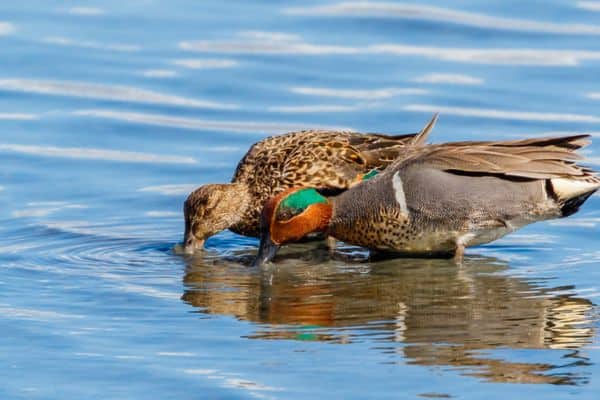
The Green-winged Teal has a relatively stable population and is classified as a species of least concern by the International Union for Conservation of Nature (IUCN). This designation indicates that the overall population of Green-winged Teals is not currently facing significant threats or decline.
Interesting Facts
1. Known for their long-distance migrations
Green-winged Teals are known for their long-distance migrations. They travel from their breeding grounds in northern North America to wintering areas in the southern United States, Mexico, Central America, and the Caribbean.
2. Capable of taking flight quickly
These ducks are capable of taking flight quickly and maneuvering with agility, which helps them evade predators and navigate through dense wetland environments.
3. Smallest dabbling ducks in North America
Green-winged Teals are one of the smallest dabbling ducks in North America, measuring around 12-15 inches (30-38 centimeters) in length.
4. Known for its swift and agile flight
The Green-winged Teal is known for its swift and agile flight, reaching speeds of up to 37 miles per hour (60 kilometers per hour) during migration.
Frequently Asked Questions
1. Are Green-winged Teals social birds?
Yes, Green-winged Teals are social birds and often form flocks during migration and winter. They can be seen gathering in large groups with other waterfowl species.
2. How long do Green-winged Teals live?
Green-winged Teals have an average lifespan of 5-10 years in the wild, although some individuals have been known to live up to 20 years.
3. Are Green-winged Teals vocal? What sounds do they make?
Yes, Green-winged Teals are vocal birds. The males produce a distinctive whistle-like vocalization during courtship displays, while both males and females emit various quacks, whistles, and trills as communication within the flock.
